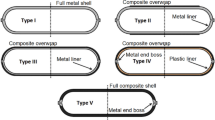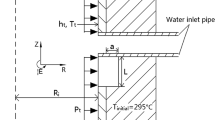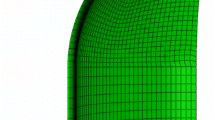Abstract
To facilitate the widespread use of fuel cell vehicles, it is necessary to ensure the safety of high-pressure hydrogen storage vessels. Because the composite layer experiences the highest internal pressure, cracks in the carbon fiber reinforced plastic (CFRP) layer of type III high-pressure vessels directly affect their safety. In this study, we evaluate the crack behavior in a type III high-pressure hydrogen vessel using a ply modeling method and the extended finite element method. The failure criteria were determined from the maximum principal stress and displacement that exceed the allowable tensile strength, considering the fiber and the transverse directions of each ply. The weak point of the CFRP composite layers was in the transverse direction on the 17th ply at a helical winding angle of 35° in the boundary of the dome and the cylinder. The crack extension was resulted from exceeding the allowable transverse stress at 35° winding angle. These results may be valuable for ensuring the safety of high-pressure hydrogen vessels.
Similar content being viewed by others
References
K. O. Bae, H. S. Shin, U. B. Baek, S. H. Nahm, J. S. Park and H. M. Lee, Influence of punch velocity on gas hydrogen embrittlement behavior in SA372 steel, Transactions of the Korean Society of Mechanical Engineers, 37 (12) (2013) 1497–1502.
J. B. Park, D. R. Kim and T. K. Hwang, Evaluation of the residual strength of CFRP composite pressure vessel after low velocity impact, Korean Society of Precision Engineering Fall Conference, 21 (3) (2008) 9–17.
S. M. Cho, C. J. Kim and Y. G. Kim, A study on the behavior of ambient hydraulic cycling test for 70MPa type3 hydrogen composite cylinder, Journal of the Korean Institute of Gas, 16 (1) (2012) 46–50.
D. S. Son and S. H. Chang, Finite element analysis for performance evaluation of type iii hydrogen pressure vessel for the clean tech fuel cell vehicles, Journal of the Korean Society for Precision Engineering, 29 (9) (2012) 938–945.
T. W. David Lin, J. C. Hsieh, N. Chindakham and D. H. Pham, Optimal design of a composite laminate hydrogen storage vessel, International Journal of Energy Research, 37 (7) (2013) 761–768.
P. F. Liu, J. K. Chu, S. J. Hou, P. Xu and J. Y. Zheng, Numerical simulation and optimal design for composite highpressure hydrogen storage vessel: A review, Renewable & Sustainable Energy Reviews, 16 (4) (2012) 1817–1827.
P. F. Liu, B. J. Zhang and J. Y. Zheng, Finite element analysis of plastic collapse and crack behavior of steel pressure vessels and piping using XFEM, Journal of Failure Analysis and Prevention, 12 (6) (2012) 707–718.
M. Fakoor, S. M. N. Ghoreishi and N. M. Khansari, Investigation of composite coating effectiveness on stress intensity factors of cracked composite pressure vessels, Journal of Mechanical Science and Technology, 30 (7) (2016) 3119–3126.
M. Perl and V. Bernshtein, 3-D stress intensity factors for arrays of inner radial lunular or crescentic cracks in thin and thick spherical pressure vessels, Engineering Fracture Mechanics, 78 (7) (2011) 1466–1477.
S. H. Lee and I. S. Jeon, 3D anlaysis of crack growth in metal using tension tests and XFEM, Transaction of the Korean Society of Mechanical Engineers A, 38 (4) (2014) 409–417.
SIMULIA, lnc., Wound composite modeler for Abaqus user's manual, Abaqus Ver. (2016).
J. H. Song, Crack propagation analysis of steel member by using the extended finite element method, Yonsei University, Korea (2002).
D. S. Son, Evaluation of modeling techniques and determination of the autofrettage pressure for a TYPE III hydrogen pressure vessel, Chung-Ang University, Korea (2013).
D. S. Son, J. H. Hong and S. H. Chang, Determination of the autofrettage pressure and estimation of material failures of a Type III hydrogen pressure vessel by using finite element analysis, International Journal of Hydrogen Energy, 37 (17) (2012) 12771–12781.
M. Perl and M. Steiner, The beneficial effect of full or partial autofrettage on the combined 3-D stress intensity factor for an inner radial lunular or crescentic crack in a spherical pressure vessel, Engineering Fracture Mechanics, 156 (2016) 124–140.
J. Schon, Coefficient of friction for aluminum in contact with a carbon fiber epoxy composite, Tribology International, 37 (2004) 395–404.
Author information
Authors and Affiliations
Corresponding author
Additional information
Recommended by Associate Editor Yang Zheng
Woo Rim Park is a graduate student of School of Department of Safety Engineering, Pukyong National University. He is a candidate of Ph.D.
Nurul Fajriyah Fatoni is a graduate student of School of Department of Safety Engineering, Pukyong National University. She is also working at Hankook Tiers in Indonesia.
Oh Heon Kwon is a Professor of Department of Safety Engineering, Pukyong National University, His Ph.D. is from University of Tokyo.
Rights and permissions
About this article
Cite this article
Park, W.R., Fatoni, N.F. & Kwon, O.H. Evaluation of stress and crack behavior using the extended finite element method in the composite layer of a type III hydrogen storage vessel. J Mech Sci Technol 32, 1995–2002 (2018). https://doi.org/10.1007/s12206-018-0407-2
Received:
Revised:
Accepted:
Published:
Issue Date:
DOI: https://doi.org/10.1007/s12206-018-0407-2




